Best of the year lists are a dime a dozen this time of year. Who can really narrow it all down to a certain number anyway? What we decided to do was to put out an open call to our writers and ask them all to chip in five shows as part of a favorites compilation. It’s a busy time of year and many writers couldn’t quite get back to us with their selections because they were too busy between drinking boozy eggnog, fighting with the mother in law, and picking out New Years party hats. Those who were excited to contribute and could find the time put together some excellent selections from NYC to Europe and beyond. Lets say just it’s a “Now This is What We Call Art, 2013.” Read through and feel free to comment on anything out there we may have overlooked:
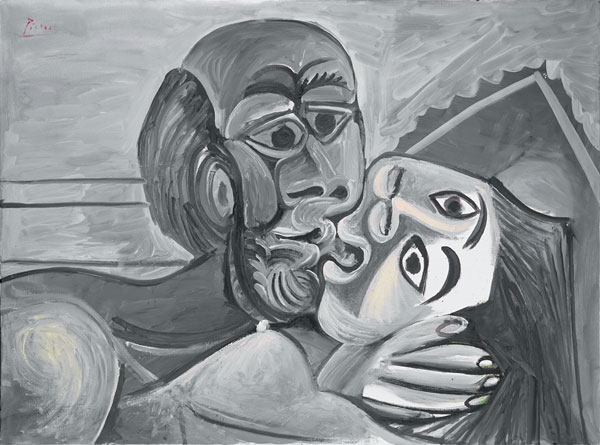
Pablo Picasso, “The Kiss (Le baiser) Mas Notre-Dame-de-Vie, Mougins,” 1969. Oil on canvas, 97.2 × 130.2 cm. Koons Collection. Copyright 2012 Estate of Pablo Picasso/Artists Rights Society (ARS), New York. Photo: David Heald.
Valery Oișteanu (born September 3, 1943) is a Soviet-born Romanian and American poet, art critic, essayist, photographer, and performance artist, whose style reflects the influence of Dada and Surrealism. Oișteanu is the author of more than a dozen books of poetry, a book of short fiction, and a book of essays.
1. Picasso Black and White at the Guggenheim Museum, New York
“Picasso Black and White” was the first ever exhibit to explore the master draftsman’s use of black-and-white tones throughout his prolific career. Comprised of 118 paintings, sculptures and works on paper, with a large number of masterpieces, as well as 38 rarely and five never-before-seen works borrowed from family and private collections. “Color weakens,” said Picasso, purging it from his art in order to highlight structure and autonomy of form.
2. Claes Oldenburg: The Street and The Store & Mouse Museum/Ray Gun Wing at MoMA, New York
This exhibition, organized by Achim Hochdorfer, Curator of the Ludwig Museum of Vienna and Ann Temkin, MoMa’s Chief Curator constitutes the largest-ever presentation of Oldenburg’s earliest witty and gritty expressionistic sculptures, arranged within an immersive, oversized environment. The sixth floor gallery was filled with his sculptures and in the atrium a room shaped like a Ray-Gun and another like a Mickey Mouse Head was filled with art objects made from materials such as chicken wire, plaster, burlap, papier-mâché and newspaper were finished off in enamel paint.
3. Paul Delvaux at Blain/DiDonna Gallery, London
Paul Delvaux (1897-1994) a mini retrospective of a major Belgian Surrealist whose last exhibition in New York was at the Julien Levy gallery in 1947 and it culminated in scandal. Back then Delvaux’s work created quite a stir; despite good reviews, the police raided the show, and all of the artist’s pictures were confiscated and declared obscene. Delvaux’s erotic art does not offend anymore; instead it attracts an aesthetic scrutiny in the course of a drastic re-evaluation. In that exhibition twenty hypnotic oil paintings and watercolors made between the mid-thirties and the mid-sixties adorned the walls of the uptown gallery.
4. Jindrich Styrsky Dreams at Ubu Gallery, New York
The story of Jindrich Styrsky (1899-1942) depicts a meteoric, renaissance-like figure who in less then two decades influenced surrealist artists and poets in his native Czechoslovakia, Paris and around the world, and also inspired Ubu’s owner, Adam Boxer, to introduce the artist’s magical masterpieces in three one-man shows and six group shows over the past two decades. His outstanding and varied oeuvre includes numerous book covers and illustrations for surrealist publications in Prague. Friendly with Andre Breton, he is credited as a pioneer of surrealism in art, literature, photography and theater in Prague as well as Paris. That small exhibit was an opening of a window on his dream-like art and life.
5. Drawing Surrealism at Morgan Library and Museum, New York
The grand retrospective was a scholarly researched, academically presented overview of an impressive 165 works on paper by 72 artists who shared their subconscious visions. Of course, surrealism proved to be not just a fashionable, passing trend in art, but a whole attitude toward life, for some even a way of life. For others, surrealism was a spiritual activity, representing the unrepresentable, visualizing forbidden dreams, exposing repressed desires. Erotic originality, collage imagination, dreams traveling and a whole plethora of imaginary beings and places made this exhibit a trip into otherworld.
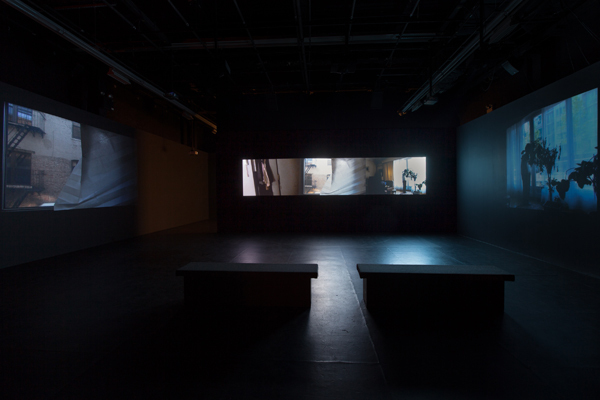
View of “Chantal Akerman: Maniac Shadows,” 2013. Photo: Jason Mandella.
Michele Alpern is an artist and writer.
1. Jean-Luc Godard, The Spirit of the Forms, at the Film Society of Lincoln Center, New York
Near-complete retrospective of a profound body of visual art spanning the last half century. Godard is unmatched in understanding cinematic form, probing the intersections of subjectivity and politics, culture and history.
2. Chantal Akerman, Maniac Shadows, at the Kitchen, New York
Akerman’s mixed-media video installation extends her work on the complications between self and other—specifically mother. The autobiographical piece juxtaposes interior and exterior spaces, evoking tension between confinement and vulnerability. As in her classic films, the imagery is mundane, yet presented at a remove. The piece gets at the fundamental obliqueness of identity.
3. Dickinson/Walser at the Drawing Center, New York
A revelatory presentation of Emily Dickinson’s poem manuscripts on scraps, predominantly envelopes, and Robert Walser’s unique “microscripts.” Dickinson’s pieces, which are mostly legible, are astoundingly experimental in their interplay between the visual, the material, and the linguistic. The exhibition opens issues of visuality and textuality, the haptic and the conceptual.
4. Mike Kelley at PS1, Long Island City
Kelley’s work made a huge impression on me in my early twenties—the way he used psychoanalytic, feminist, and semiotic theory along with punk aesthetics and working/middle class American vernacular culture. Seeing this retrospective, especially the second and third floors, still had the same surprisingly emotional impact. Kelley goes to the painful and abject, and it resonates.
5. Ad Reinhardt at David Zwirner, and Richard Aldrich at Bortolami, New York
A strange pairing of painting shows I first saw on the same day. Not only were Reinhardt’s brilliant cartoons, paintings, and photography shown in one exhibition, but an extraordinary thirteen of the “black” paintings were beautifully installed in one room. We could move among the paintings at different distances and realize how particular each ostensibly similar one is, opening awareness of the endless oscillations and revisions involved in perception.
Aldrich’s work is increasingly about the relay of vision across pieces rather than within the bounds of an object. This show also operated across temporal interstices in memory: a second installation of mostly different work replaced the first for ten days during the run. I found the show often baffling, while evoking a challenging, and moving, sense of contingency.
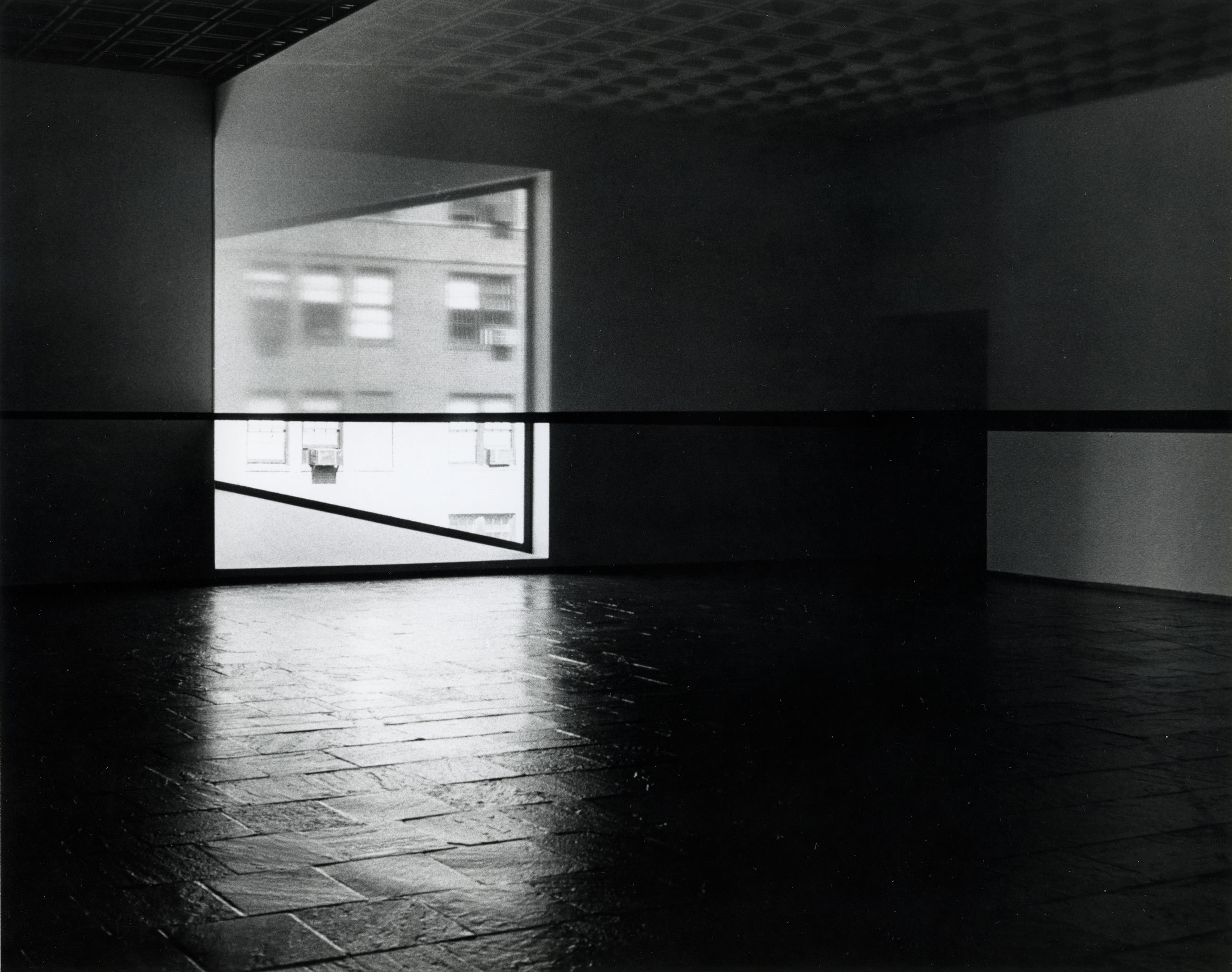
Robert Irwin (b. 1928), Scrim veil—Black rectangle—Natural light, Whitney Museum of American Art, New York, 1977. Cloth, metal, and wood. Overall: 144 × 1368 × 49 in. Whitney Museum of American Art, New York. Photo Credit: Warren Silverman.
Charlotte Meyer lives in Brooklyn, N.Y., graduated from Pratt Institute in 2009, and received the Joan Mitchell Foundation Award in recognition of the school. She is a Visiting Critic at R.I.S.D. is represented by Opus Projects, and is scheduled to exhibit new work at the Chelsea location in 2014.
1. Robert Irwin: Scrim Veil -Black Rectangle -Natural Light at Whitney Museum, New York
A reminder of Irwin’s dedication to understanding perceptual awareness of space by transforming the fourth floor of the Whitney with an intricate but barely there work, recreated after 35 years.
2. Ad Reinhardt at David Zwirner, New York
The black paintings fill one room with subtle details which reveal themselves with each moment you spend, smart political graphic illustrations provide a layer mostly unknown, obsessive photography slides in the hundreds.
3. Jill Magid: Woman with Sombrero at Art in General, New York
The investigative nature of Magid’s work paired with the skilled manifestation of sharing just enough information seduces every time.
4. Subliming Vessel: The Drawings of Matthew Barney at Morgan Library, New York
Intense research, developed language, constant movement, revealing process, considered materials.
5. Dickinson/Walser: Pencil Sketches at Drawing Center, New York
Old fashioned writing thoughts down on beautiful scraps of paper.
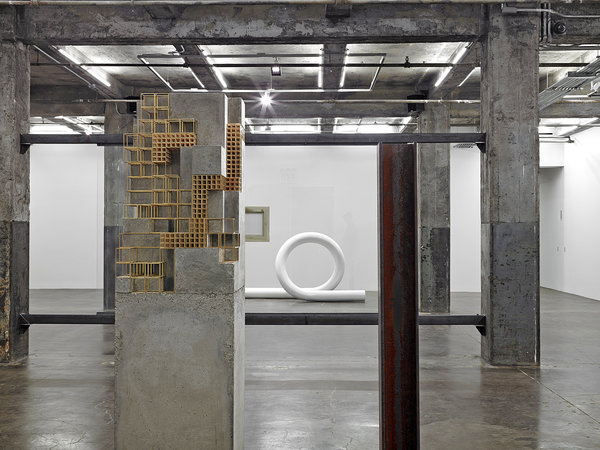
“Peel’s Foe, not a set animal, laminates a tone of sleep” (2013), in brass and concrete, by Carol Bove at Maccarone.
Keith J. Varadi is an artist, writer, and curator currently based in Los Angeles. He is a co-founder and member of the collective, Picture Menu.
1. Larry Bamburg, BurlsHoovesandShells at Simone Subal Gallery, New York
Jerry-rigged ecosystems, towers constructed from bones and gold, and artificial earth compositions made for, hands down, one of the most profoundly perplexing shows in recent memory (at one of the most consistently superb galleries in New York).
2. Carol Bove, RA, or Why is an orange like a bell? at Maccarone, New York
Nobody combines smart and sexy better than Ms. Bove, and this is arguably her smartest and sexiest affair yet, continuing on with her rigorously researched explorations into ascetic aesthetics.
3. Elizabeth Jaeger, Music Stand at Eli Ping, New York
A nude woman with a devilishly delightful look on her face, straddling a suited man with her hand caught mid-caress on his face, provided a subtle subversion of power in the intimate Lower East Side basement gallery this past summer; oh, and there was a saxophonist playing every Sunday afternoon during its run.
4. Jamian Juliano-Villani, Me, Myself, and Jah at Rawson Projects, New York
After creating substantial buzz at this past spring’s otherwise generally confused NADA fair in New York, this little firecracker could be seen everywhere throughout the boroughs and on the Internet, and this Brooklyn gallery made a wise move by opening the fall season with her, as she is rapidly asserting herself as a demented voice to be reckoned with.
5. Paul McCarthy: White Snow at The Park Avenue Armory, New York
Rarely has commentary been so abundant amidst a viewer’s navigation throughout an exhibition—comments of amusement and disgust echoed within the Upper East Side’s cavernous space—and for good reason; this modern pop-fused Bacchanalia completely transformed the public’s idea of what an art show truly can be.
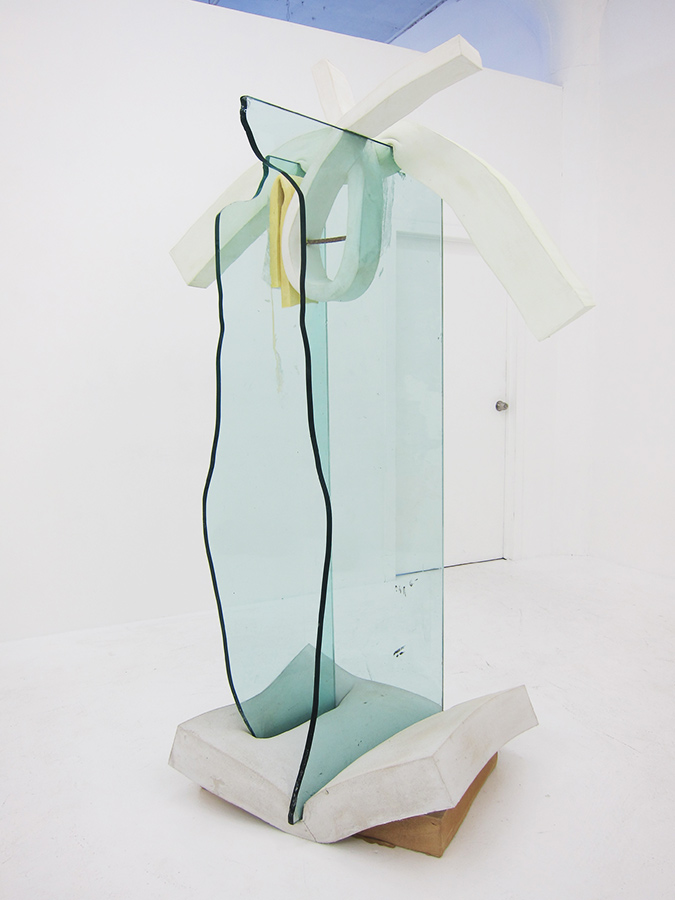
Dave Hardy, Hunky-dory (2013), glass, cement, polyurethane foam, ink, paper, metal, pretzel,etc 86 x 57 x 33 in. Image courtesy of Regina Rex.
Claudia Eve Beauchesne is an art historian, writer and curator. She is currently curator of programming at Formats in Montreal, Canada, and is working on a non-fiction book about the East Village art scene of the 1980s. Her writing on contemporary art, cinema and popular culture has appeared in NY Arts, Packet, Kolaj, I Love Bad Movies, and Come on Down.
1. Generator at Audio Visual Arts (AVA), New York
An exhaustive and well-deserved homage to Gen Ken Montgomery’s Generator, New York’s first sound art gallery which existed in the East Village and then in Chelsea from 1989 to 1992.
2. Dave Hardy, A House with Gates at Regina Rex, Brooklyn, NY
Large vinyl wall hangings and precarious sculptural constructions made of discarded pliable foam, glass, cement, wood and furniture. The most innovative use of found materials this year.
3. The Perfect Nothing Catalog at Ongoing, Brooklyn, NY
A nomadic installation somewhere between a store, a curatorial project, a situationist intervention, and a relational aesthetic project. Uncategorizable and inconspiciously sophisticated.
4. John Dante Bianchi: Dislocation Point at SIGNAL, Brooklyn, NY
Large white relief panels created through a process of erosion and degradation, combined with white fiberboard sculptures that appear oxidized; almost iridescent. A fresh take on monochromatic abstraction.
5. Shaq Attack! At BOCA Gallery, Montreal
A conceptual online advertising campaign using Google AdSense to target a product (a customized work of art) at a single individual: Shaquille O’Neal. A smart (and funny) critique of internet-mediated marketing.
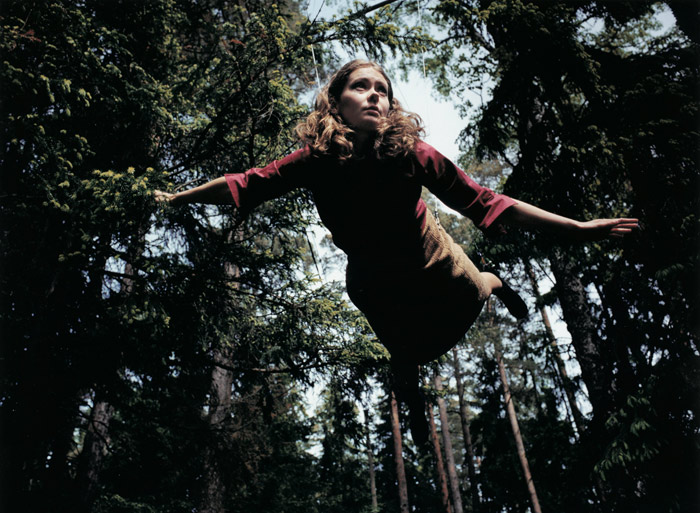
Eija-Liisa Ahtila, still from The House, 2002. 14 min DVD installation for 3 projections with sound. Copyright Crystal Eye Ltd, Helsinki, Courtesy of Marian Goodman Gallery, New York and Paris.
Stephen Knudsen is an artist and professor of painting at Savannah College of Art and design. He is the senior editor of ARTPULSE Magazine, a contributing writer to the Huffington Post, NY Arts Magazine, and Hyperallergic. He is the senior editor of the anthology the Art of Critique, forthcoming in 2014.
1. Eija-Liisa Ahtila: Olentoja (Creatures) at the Davis Museum at Wellesley College, MA
Finnish artist Eija-Liisa Ahtila has been a figure in the vanguard movement re-imagining film art into multiple screen pieces with cinematic production values. This exhibition of her key works includes House (2002), one of the best pieces in the movement. This work demonstrates that beauty and transcendence does not have to be put into the satirical air quotes of postmodernism to be critically and aesthetically relevant.
2. Nicole Eisenman’s work in the Carnegie International Exhibition, Carnegie Museum, Pittsburgh
The highlight of this well- conceived iteration of the Carnegie International is Nicole Eisenman’s survey of work up to 2011. She was the winner of this year’s Carnegie Prize. Included works like The Sunday Night Dinner have placed Eisenman as one of the most important 21st century painter who cast back to the roots of expressionism without evoking the weaknesses of 1980’s Neo-expressionism.
3. Laura McPhee: River of No Return at Kemper Contemporary Museum of ART, Kansas City
Laura McPhee is a final holdout in the line of great large format photographers using the 8 by 10 camera and pulling prints with traditional chromogenic chemistry. The show’s twenty-three mural sized ( 6 by 8 feet)chromogenic prints were photographed over several years in the ranch land and wilderness of central Idaho. An exceptional inclusion, Mattie with a Northern Red-Shafted Flicker, is a fresh and relevant iconic image that is resolute and easy to love, even without backstory.
4. The Gallery Booth for La Central Gallery, Bogota, Columbia at Miami Beach Art Basel, Miami
The La Central gallery dedicated all of its Art Basel space to Nicolas Consuegra’s 15 channel video installation that to my eyes was the best extended cinema piece in Art Basel ( and the satellite fairs) this year. The Water that you Touch is the Last of What has Passed and the First of that Which Comes chronicled the Magdalena river as it runs through a depressed small town outside of Bogotá. Presented as a moving ring, the river becomes a sensual emblem of rushing infinitudes and potential for a town that is in socioeconomic stagnation . See it here: http://vimeo.com/81408376
5. Benjamin Degen’s Shadow Ripple Reflection at Susan Inglett Gallery, New York
With Shadow ripple reflection , an uplifting exhibition of eight new paintings, Benjamin Degen showed us that he is better than ever. These works skirt dangerously close to cliché: sunshine, youthful figures lounging, reading, swimming, and setting out, and returning. But they take positive hold on the memory because they seem so unfamiliar in fanatical web-like detail in places that contrast with the simpler handling of the flesh. In the most complex passages it is as if the pigment spun from spinnerets of a spider. The work may nod toward Matisse, Bonnard, Seurat, Renoir, and Gauguin, but it is absolutely recognizable only as itself.

Megan Rooney “Everything’s the same this is my dream” installation view at Baustelle Schaustelle. Image courtesy of Baustelle Schaustelle.
Paul Kneale is an artist and writer based in London. Past work can be found here. Kneale’s upcoming shows and projects include Art Gallery of Ontario, GalleriesLafayette Paris, And/Or London. He coruns Library+ project space and plays in the band TINA.
1. Morag Keil, Potpourri at Cubitt Gallery, London
Consisting of a single video that was also available online, positioning a visit to the space as nearly redundant. snippets of dialog from a celeb sex tape rehearsed in mundane settings who’s filming seemed alternately meticulous and distracted. HD/SD. Choices. A strobe light held on a moving motorcycle. This video somehow unsettled me more than anything I’ve seen recently on /b/. The title ‘Potpourri’ recalling the proximity of media culture to scented toilets.
2. Raymond Pettibon, Human Wave at SPACE, London
In a year filled with vacuous formalism masquerading as network kitsch, this show of the artist’s lesser known videos was a breath of punk smog. The degraded quality of the VHS originals seemed to ridicule the current vogue for early digital crap as an aftereffect. Kim and Thurston rating and smashing records. Quasireligious ceremonies filled with howling. Perfectly installed with a collection of random office chairs as seating.
3. Georgie Nettell at Project Native Informant, London
A show that was aggressively indifferent to itself. Variations of serialised works, printed on canvass in colour schemes to match the galleries’ textures. Sections of the drywall theatrically removed as if to say, ‘work is here’. Everywhere a palpable urge to go on. Nowhere any horizon to meet.
4. Megan Rooney, Everything’s the same this is my dream at Baustelle Schaustelle, Essen
The weirdest show I saw this year achieved an uneasy levity. A bronze cheetah borrowed from Europe’s largest brothel was both present and depicted in scores of tender watercolors. A wall text rendered in faux teenage girl handwriting described a moment in said club suspended between enlightenment and existential crisis. Plato’s cave redecorated.
5. Bea Schlingellhof, Onaboat at AP News, Zurich
The glass exterior walls of this shopping mall-located gallery were covered by bluewashed posters emblazoned with ‘TOD’, German for death. Inside people smoked vigorously, pursued some racist books and watched a film on Jacques Cousteau. The artist produced a pointed discourse about gender and exploration that evaded localization in an object, or terra firma.























